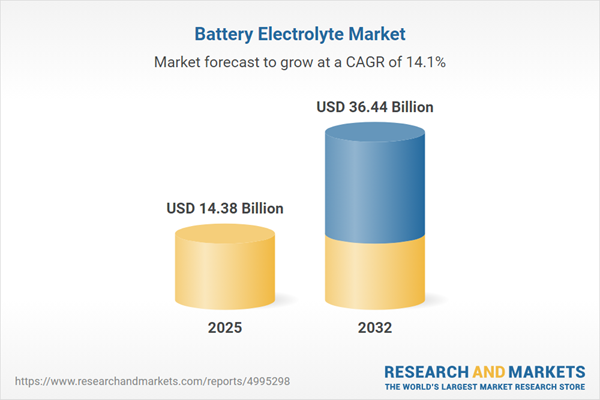Speak directly to the analyst to clarify any post sales queries you may have.
The battery electrolyte market is advancing rapidly as manufacturers prioritize innovation in energy storage efficiency, safety, and sustainability across automotive, energy, and industrial sectors. Senior executives require a comprehensive overview of current dynamics, key growth levers, and evolving supply chains to make informed investments and strategic decisions.
Battery Electrolyte Market Snapshot
The Battery Electrolyte Market grew from USD 12.69 billion in 2024 to USD 14.38 billion in 2025. It is expected to continue growing at a CAGR of 14.09%, reaching USD 36.44 billion by 2032. Robust market expansion is driven by rising adoption of electric vehicles, ambitious renewable energy initiatives, and a shift towards advanced battery chemistries. These trends highlight how innovative electrolyte systems are critically shaping the next generation of energy storage solutions across global industries. The primary keyword, battery electrolyte market, identifies the strategic value of this insight for industry leaders seeking actionable intelligence.
Scope & Segmentation
This report delivers granular segmentation and targeted insights tailored for senior decision-makers navigating investment, R&D, and procurement in the battery electrolyte space. The analysis is structured as follows:
- Product Type: Gel electrolytes, liquid electrolytes, solid electrolytes
- Battery Type: Lead-acid batteries, lithium-ion batteries, nickel-metal hydride batteries, sodium-ion batteries
- Application: Automotive (electric vehicles, hybrid vehicles), consumer electronics (laptops, smartphones, wearables), energy storage systems (commercial, residential), healthcare
- Geography: Americas (United States, Canada, Mexico, Brazil, Argentina, Chile, Colombia, Peru), Europe, Middle East & Africa (United Kingdom, Germany, France, Russia, Italy, Spain, Netherlands, Sweden, Poland, Switzerland, United Arab Emirates, Saudi Arabia, Qatar, Turkey, Israel, South Africa, Nigeria, Egypt, Kenya), Asia-Pacific (China, India, Japan, Australia, South Korea, Indonesia, Thailand, Malaysia, Singapore, Taiwan)
- Key Companies: 3M Company, American Elements, Ampcera Corp., Arkema S.A., BASF SE, CAPCHEM, DAIKIN INDUSTRIES, Dongwha Group, E-Lyte Innovations GmbH, GS Yuasa Corporation, GuangDong JinGuang High-Tech, Guotai Huarong Poland, Johnson Controls Battery Group, LANXESS, LG Chem, Mitsubishi Chemical Corporation, NEI Corporation, Ohara, Samsung SDI, SIONIC ENERGY, Soulbrain Mi, Stella Chemifa, Targray Technology International, UBE Corporation, Zhangjiagang Guotai Huarong New Chemical Materials
Key Takeaways for Senior Decision-Makers
- Electrolyte innovation is essential for optimizing energy density, lifespan, and safety in modern battery systems, influencing product differentiation and compliance strategies.
- Technological advances in gel, liquid, and solid electrolytes enable targeted performance across distinct battery chemistries and applications, supporting diverse end-user requirements.
- Strategic partnerships among raw material suppliers, battery manufacturers, and OEMs are reshaping the competitive landscape through vertical integration and localized value chains.
- Supply-chain resilience is enhanced by investment in domestic production and alternative chemistries, especially as volatility in regulatory and global trade environments influences long-term planning.
- Data-driven R&D accelerates formulation optimization and reduces time to market, leveraging machine learning and advanced analytics to address evolving technical and regulatory requirements.
- Sustained regulatory emphasis on low-toxicity and recyclable components underscores the importance of environmental stewardship in portfolio development and procurement.
Tariff Impact: Navigating New Trade and Sourcing Pressures
Imminent US tariffs on key electrolyte raw materials and finished products are expected to increase operational costs and disrupt established supply chains. Companies are responding by diversifying supplier bases, exploring tariff-free sourcing, and investing in local production. These measures support margin preservation, manage price volatility, and reduce dependency on external sources. New joint-venture facilities and strategic stockpiling strategies further illustrate proactive risk management in the face of shifting trade policies.
Methodology & Data Sources
This market intelligence report synthesizes rigorous primary research—structured interviews, facility visits, and expert panel validation—with in-depth secondary analysis of industry literature, patents, official filings, and company disclosures. Quantitative and qualitative findings are cross-verified and peer-reviewed by subject-matter experts to ensure actionable and reliable insights throughout all sections.
Why This Report Matters
- Empowers leadership to align R&D and procurement with regulatory and sustainability priorities, ensuring strategic positioning as technologies and supply chains evolve.
- Provides a detailed roadmap of product types, application dynamics, and regional opportunities to guide growth, investment, and risk mitigation decisions.
Conclusion
Senior stakeholders gain clarity on technological advancement, supply-chain shifts, and regulatory changes driving value in the battery electrolyte sector. This report delivers actionable insights to support innovation, adaptability, and sustained market competitiveness.
Additional Product Information:
- Purchase of this report includes 1 year online access with quarterly updates.
- This report can be updated on request. Please contact our Customer Experience team using the Ask a Question widget on our website.
Table of Contents
3. Executive Summary
4. Market Overview
7. Cumulative Impact of Artificial Intelligence 2025
Companies Mentioned
The companies profiled in this Battery Electrolyte market report include:- 3M Company
- American Elements
- Ampcera Corp.
- Arkema S.A.
- BASF SE
- CAPCHEM
- DAIKIN INDUSTRIES, Ltd.
- Dongwha Group
- E-Lyte Innovations GmbH
- GS Yuasa Corporation
- GuangDong JinGuang High-Tech Co., Ltd.
- Guotai Huarong Poland Sp. z o.o.
- Johnson Controls Battery Group, Inc.
- LANXESS AG
- LG Chem Ltd.
- Mitsubishi Chemical Corporation
- NEI Corporation
- Ohara Inc.
- Samsung SDI Co., Ltd.
- SIONIC ENERGY
- Soulbrain Mi
- Stella Chemifa Corporation
- Targray Technology International Inc.
- UBE Corporation
- Zhangjiagang Guotai Huarong New Chemical Materials Co.,Ltd.
Table Information
| Report Attribute | Details |
|---|---|
| No. of Pages | 187 |
| Published | November 2025 |
| Forecast Period | 2025 - 2032 |
| Estimated Market Value ( USD | $ 14.38 Billion |
| Forecasted Market Value ( USD | $ 36.44 Billion |
| Compound Annual Growth Rate | 14.0% |
| Regions Covered | Global |
| No. of Companies Mentioned | 26 |









